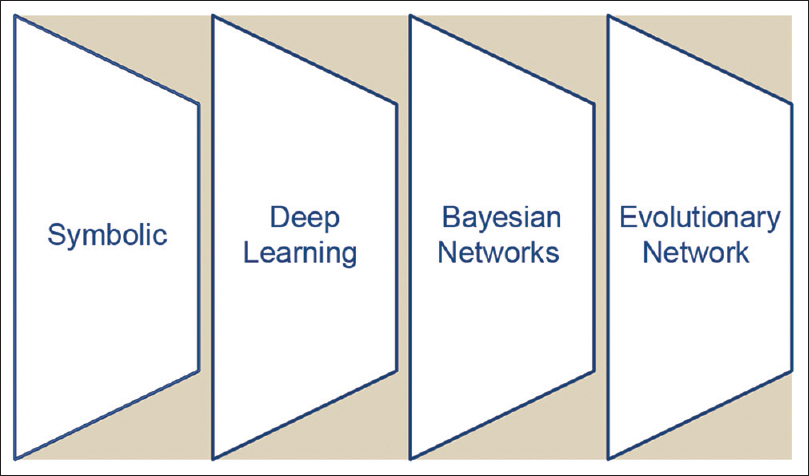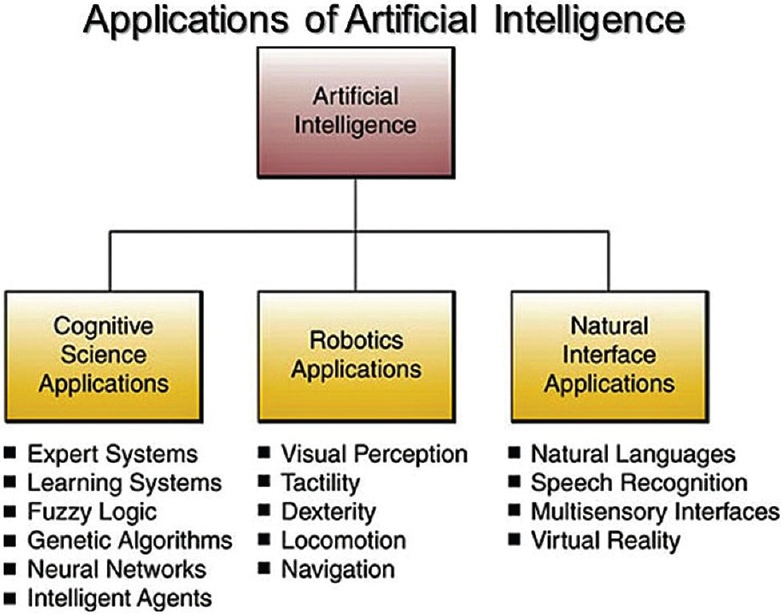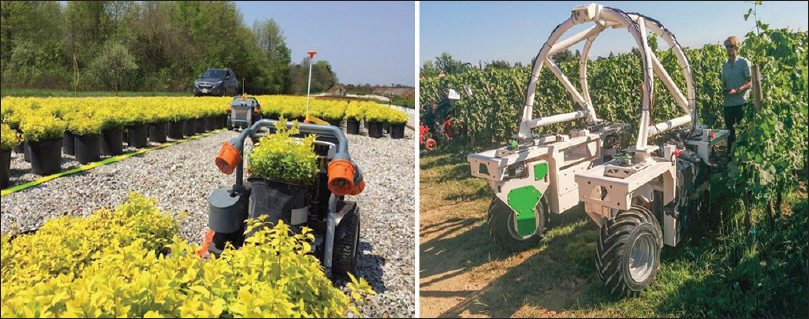INTRODUCTION
Modern world is toward more smart, sophisticated and intelligent supported by various kinds of tools, technologies. Contemporary world becomes more scientific, modern, and technologically equipped with due to Information Technology and Computing in many contexts. Artificial intelligence (AI) is an important part of computing which is responsible for developing intelligent systems and also dedicated to developing intelligence powered by the machines and referred to as intelligent agents. Since AI is associated with the machines; therefore, it is also called machine intelligence; dedicated to learning and problem solving. Computational statistics is playing an important role in giving prediction by the use of computers. Mathematical optimization is here important with suitable methods, theory, and applications. Robotics is an interdisciplinary area and involves with intelligent systems and robots designing, construction, operation, etc. Among the components of IT few important are database technology, multimedia technology, network technology, software technology, etc., and within these technologies, some sub, and emerging areas are booming, namely, AI, Big Data, Cloud Computing, Robotics, HCI, and so on. AI applications in other sectors and areas including agriculture developed the overall scenario (Aravind et al., 2017; Paul et al., 2013; Paul et al., 2016). The need and huge amount of agricultural product requirements in coming age can only be solved by AI support. UN Food and Agriculture Organization has expressed that by 2050 the world population will reach to 2 billion and in this regard only 4% additional land can be cultivated then. The latest technological solutions promoting efficiency, greatest imperatives, etc., and it can be helpful in bringing a paradigm shift in how we see farming today.
Objective
The present paper entitled ‘AI and Robotics in Agriculture and Allied Areas – A Study’ deals with the following aim and objective (but not limited to)—
-
• To learn about the basics of technological relation and integration with the agricultural systems.
-
• To know about the field and domain agricultural informatics with its origin and development.
-
• To know about the fundamentals of AI and robotics with reference to its applications, types, etc.
-
• To learn about the basics of AI uses in agriculture and allied areas in the contemporary scenario.
-
• To know about the growing robotics and AI areas in agricultural systems with fundamentals of issues, challenges, etc.
AGRICULTURAL INFORMATICS, AI, AND ROBOTICS: BASICS
Agricultural informatics is an important part and branch of informatics. Informatics is also called as information science. This is the application of information technology in different sectors and areas, namely, health, agriculture, education, government, and business. Therefore, the application of IT in agriculture is called agricultural informatics (Vougioukas et al., 2005; Yaghoubi et al., 2013). In agricultural informatics different types of emerging and basic technologies are used, namely.
-
• Software Technology
-
• Web Technology
-
• Database Technology
-
• Network Technology
-
• Multimedia Technology.
AI is supported by various types of AI systems including tools, systems, products, and services. Today’s machines have become more and more intelligent and perform a healthier and better way due to the availability of intelligent systems. Intelligent, advanced, human speech, inbuilt strategic systems, intelligent routing, and operating cars are important features in modern AI. Knowledge reasoning, machine learning (ML), computer vision, natural language processing, etc., are considered as core activities in AI. Regarding its approaches and has depicted in Figure 1.
Figure 1: Basic approaches in artificial intelligence
AI is basically connected with the data mining which is focused on exploratory data analysis by unsupervised learning and here predictive analytics are also used. AI is interconnected with each other as a system with developing intelligence systems in the products, services, and systems. AI integrated machines perform such as humans and also mimic their actions. AI is therefore needed in learning and problem-solving and also the ability to rationalize and take actions to reach a specific goal (Bechar and Edan, 2003; Kamble et al., 2020; Reddy et al., 2016). AI utilizations are using different areas, sectors, and industries, namely, health-care, governance, business and commerce, politics and administration, transport and tourism, and education and teaching. AI has become worthy in automated machines, intelligent devices and products, self-driving cars, etc. AI is also widely increasing in the areas, namely, financial industry, banking, and finance are increased for higher capacity and growth. AI should be considered with the following features and functions, namely:
-
• This is dedicated to the simulation, human like intelligence in different kinds of devices as well as machines.
-
• AI is worthy of learning, reasoning, and perception.
-
• Based on need weak AI and strong AI may be used.
There are two major types of AI, namely, weak AI and strong AI. In this more complex and human-like activities are performed by the strong AI whereas Weak AI is for smaller and lees AI based systems and devices. In designing the system, strong AI is more applicable, also in developing a robot. In a more complex and complicated system, the task to be human-like is normally performed by AI. More complex and complicated systems to the basic problem without having a person can be solved without a person and therefore AI is applicable in three basic areas [Figure 2].
Figure 2: Basic applications in artificial intelligence
Robotics is also supported by the AI and partially expert systems. Robotics is powered by the programmable computer and does the performance automatically based on the task. The robotics system is the integrated systems and can be built inside or outside of a machine or device (Balamurugan et al., 2016; Gómez-Chabla et al., 2019). A robot always looks like a human being and may hold any form or shape. However, robots are operated automatically in diverse areas and sectors, namely, healthcare, business, agriculture, transportation, and manufacturing. In agriculture, robotics is worthy in pre- and post-production and similar sectors, namely, harvesting, watering, and marketing. A drone is robotics supported and may be used in—
-
• Weed controlling
-
• Plant seeding
-
• Environmental assessing and monitoring
-
• Soil mapping and analysis, etc.
Information technological tools are worthy in agricultural practices and among these, emerging technologies are important, namely, Cloud Computing, Big Data, HCI, Usability Engineering, Robotics, and AI. Robotics is increasing gradually due to various reasons (Bechar and Vigneault, 2016; Paul et al., 2015).
AGRICULTURAL INFORMATICS AND AI TASK
Applications of information technology can lead the Development of Agriculture in many contexts and in this context apart from the core components of information technology other emerging areas also referred in Figure 3. However, software technology, web technology, networking technology, multimedia technology, and database technology play a key role in general agricultural computing or digital agricultural practice (Aubert et al., 2012; Gill et al., 2017). There are many uses of IT and computing in agriculture as each and every day variety of things are generating data and these can be weather conditions, temperature, water usage or soil conditions, etc. These real time data are worthy in modern systems of agriculture; therefore, in the planning of agriculture and farmers, AI is considered as important to generate more bountiful yields by determining crop choices. In precision agriculture and harvesting system also AI are very important. In detecting diseases in plants, pests, and AI based sensors can collect the data and helpful in detecting further. AI is also important in improving agricultural accuracy and productivity using the development of suitable which can also able in predicting weather patterns and make positive sense to take decisions of farmers. Seasonal forecasting is applicable in small farms particularly in developing countries and here AI and robotics based technologies are important. This can be considered as important as these small farms produce 70% of the corps in the world (Babu et al., 2015; Goraya and Kaur, 2015; Na and Isaac, 2016).
Figure 3: Precision agriculture using artificial intelligence and allied technologies
With the help of AI apart from the ground level data gathering and monitoring data can also possible to collect from the sky using drones, etc., and therefore important in further agricultural activities. Here apart from core AI applications, robotics, computer vision and deep learning, ML algorithms process data captured from drones flying, and this way entire farm management become easy electronically. In real time and potential improvements unmanned drones are worthy with less human effort and with the benefit of timesaving having monitored more frequently (Edan, 1995; Ozdogan et al., 2017; Sakai et al., 2008). Chatbots are also important in healthy agricultural informatics practice by helping answer of a variety of questions on specific farm problems. AI and cognitive technologies are gaining day by day due to various advantages and benefits and as a result precision agriculture becomes possible (as depicted in Figure 3).
Most agricultural units are facing challenges in skilled workforce shortage and AI can play an important role in respect of developing skilled manpower which results in better harvesting, farm productions. The rapid growth of AI and ML, cognitive computing is enhancing traditional agricultural systems and services to the automated and digital ones. Agriculture plays an important role in most countries due to the economic role by the agriculture; therefore, it is treated as an important for development. Agricultural Informatics, the field of practice and study is responsible for the proper ICT system in agriculture enhancement and it is worthy both in developing and undeveloped countries (Hameed et al., 2013; Rezník et al., 2015). As of now, millions of farmers are having minimum or marginal holdings and semi-skilled in contemporary cultivation methods, and in this respect, AI plays an important role. Agricultural systems including AI is worthy of managing heat, cold, flood, drought, insect, pest infestations, disease detection, weather and climate change, and analysis. Agro informatics is applicable nicely in managing current issues in agriculture. In developing global trade, technological improvement, ecological concern, and AI are applied directly and indirectly.
Strategically as well as methodologically AI and other allied technologies are important and applicable for strengthening agricultural systems (but not limited to)—
-
• AI promotes input and output systems
-
• Enhancing integrating and facilitating
-
• Agro Marketing using AI
-
• Smarter and automated agricultural post-production
-
• Enhancing food security systems regarding agriculture
-
• Development of effective agricultural promotion
-
• In developing healthy AI value-chain development
-
• In smarter and advanced climate systems and development
-
• In proper supply-chain systems and models.
There are many fields and technologies such as information sciences, information technologies, ICT, and computing sciences can be considered as worthy in digital agriculture systems, (Paul, P.K., Kumar, P., Ghosh, M. and Chaterjee, D, 2014 & TongKe, F. 2013) namely, pre-production and post-production activities and also for the better results, efficiency skills in both agricultural. The productivity, economic, and social development are truly possible with the agricultural informatics and AI practice in many contexts (Bauckhage and Kersting, 2013; Paul et al., 2015; Vougioukas et al., 2005). Here attentions in the following areas are important in developing solid AI practice in agriculture, namely:
-
• Accurate and the perfect amount of skilling
-
• Healthy and the proper amount of knowledge of the agricultural field
-
• Proper communication skills
-
• Entrepreneurship skills in AI professionals working in agriculture
-
• Leadership qualities.
AI in agriculture is dedicated to improving efficiency by proper monitoring of cultivation areas including agro products management, in real time.
Expansion of the agricultural systems can be powered by the AI assisted systems and also in cleaning and purity of agricultural systems. Different kinds of tools and devices are worthy in managing pesticides and fertilizers, etc., and among such devices, AI play a leading role. AI also promotes the quicker agricultural systems and ultimately in the promotion of healthy and quality production of agricultural systems, namely, aerial drone monitoring systems. In livestock management such as post-production, marketing also AI can be an important name (Ahmad et al., 2015; Kajol and Akshay, 2018; Tanner et al., 2001). Therefore, apart from these, AI in agriculture can be useful in the following—
-
• Disease detection
-
• Crop readiness identification
-
• Field management
-
• Optimal mix of agro products
-
• Agro health monitoring
-
• Precision farming Paul et al., 2015; Reddy et al., 2016.
There are different devices and tools uses are increasing which are supported by the AI, Robotics, etc., some of the devices are noted in Figure 4.
Figure 4: Samples of few artificial intelligence based tool example in agricultural sector
CHALLENGES AND ISSUES
AI, robotics, and similar technologies are offered various technological supports in agriculture but there are many issues in this respect and among these, important are lack of familiarity regarding AI and ML solutions. Some of the external factors such as weather conditions, soil conditions, and the presence of pests identification are little difficult in certain cases (Channe et al., 2015; Pedersen et al., 2006). Planning during the start of harvesting is an important issue supported by AI. Fund and financial issue is another important concern regarding AI applications in agriculture. Development of knowledgeable manpower with degrees and research expertise in this field is expected to solve future problems and solid growth in many contexts. AI and complete agricultural informatics practice need efforts from the government, policymakers, institutions, etc.
CONCLUSION
Agricultural robots including AI based systems are noticeable in some of the developing countries for the wider benefits including business and operation. In farming milk-bot, drones, automated tractor, harvester, sprayers, and other agricultural robots are increasing which ultimately helpful in allied fields such as horticulture and environmental monitoring and management. Agricultural robots were initially only used in some context and gradually in diverse areas and sectors AI become important. The sophisticated development of intelligent devices and machines, emerging information technology based machines is possible with AI practice. Training, skilling, and academic programs are essential to introduce in agricultural AI practice. Even in running agricultural informatics specialization with AI can be offered. Solving such issues is very much important in the development of agricultural industry in a certain context.



